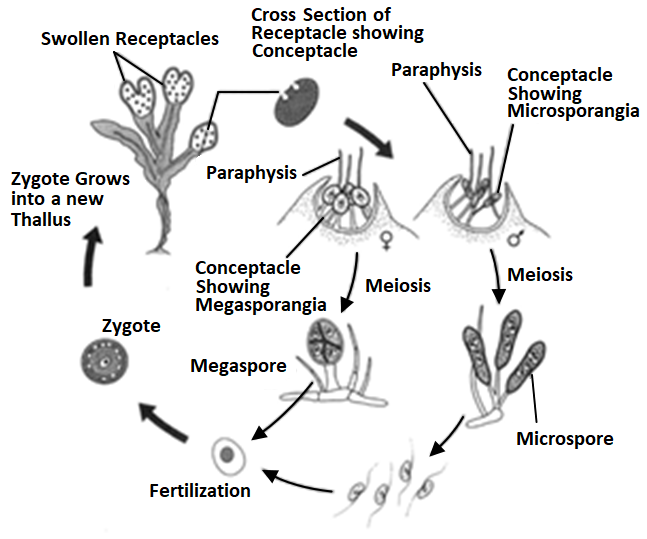The diagram shows a sorus in section in ferns. What would be the name for A?

1. Annulus
2. Placenta
3. Indusium
4. Stomium

2. Placenta
3. Indusium
4. Stomium
The given pattern of life cycle will be seen in:
| 1. Spirogyra | 2. Fucus |
| 3. Ectocarpus | 4. Polysiphonia |
The given pattern of life cycle will be seen in:
| 1. Spirogyra | 2. Fucus |
| 3. Ectocarpus | 4. Polysiphonia |
The given pattern of life cycle will be seen in:
| 1. Spirogyra | 2. Fucus |
| 3. Chlamydomanas | 4. Polysiphonia |
In the given longitudinal section of archegonium of moss identify A, B, C and D respectively:
1. Ventral canal cell, Neck canal cell, Egg, Venter
2. Ventral canal cell, Neck canal cell, Venter, Egg
3. Neck canal cell, Ventral canal cell, Venter, Egg
4. Neck canal cell, Ventral canal cell, Egg, Venter
The given diagram shows the life cycle of:
1. Polysiphonia
2. Fucus
3. Laminaria
4. Ectocarpus
Match each item in Column I with one in Column II and select the correct answer from the codes given:
|
Column I |
Column II |
|
A. Floridean starch |
a. It is created by photosynthesis and is made up of β(1→3)-glucan with β(1→6)-branches |
|
B. Laminarin |
b. An α-linked glucose polymer with a degree of branching intermediate between amylopectin and glycogen |
|
C. Mannitol |
c. A sugar alcohol, an isomer of sorbitol |
Codes
| A | B | C | |
| 1. | a | b | c |
| 2. | a | c | b |
| 3. | b | a | c |
| 4. | c | b | a |
In the given diagram of Funaria, what are A, B, C and D respectively?

1. Sporophyte, Gametophyte, Female branch, Male branch
2. Gametophyte, Sporophyte, Female branch, Male branch
3. Sporophyte, Gametophyte, Male branch, Female branch
4. Gametophyte, Sporophyte, Male branch, Female branch
The given diagram shows:
1. Male thallus of Marchantia
2. Female thallus of Marchantia
3. Sphagnum sporophyte
4. Sphagnum gametophyte
The given diagram shows:
| 1. | Salvinia with A being antheridial branch and B being archegonial branch |
| 2. | Salvinia with A being archegonial branch and B being antheridial branch |
| 3. | Sphagnum with A being antheridial branch and B being archegonial branch |
| 4. | Sphagnum with A being archegonial branch and B being antheridial branch |













